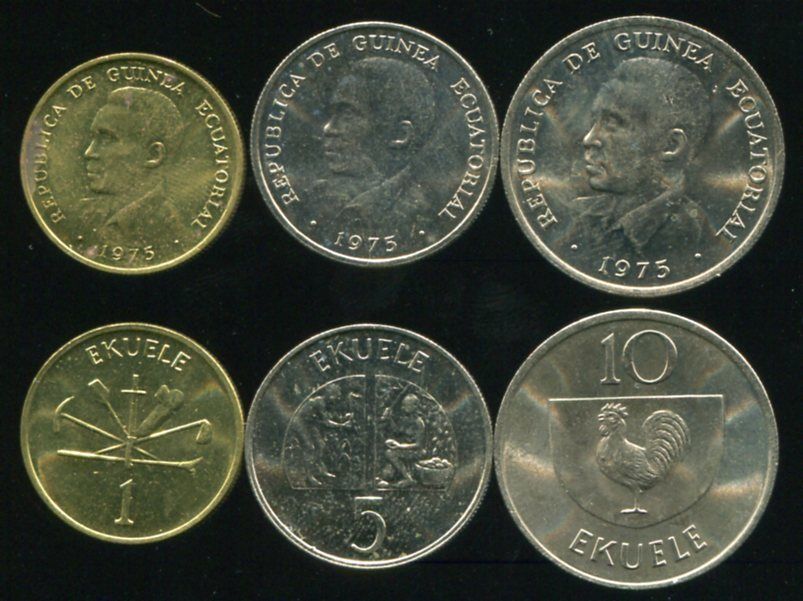Equatorial Guinean ekwele on:
[Wikipedia]
[Google]
[Amazon]
The ekwele or ekuele was the

currency
A currency, "in circulation", from la, currens, -entis, literally meaning "running" or "traversing" is a standardization of money in any form, in use or circulation as a medium of exchange, for example banknotes and coins.
A more general ...
of Equatorial Guinea between 1975 and 1985. Although nominally divided into 100 ''céntimos'', no subdivisions were issued. The name ekuele (plural the same) was used until 1979, whilst ekwele (plural ''bipkwele'') was used after. The renaming of the currency to "ekwele" from "peseta" was motivated largely by a sweeping Africanization
Africanization or Africanisation (lit., making something African) has been applied in various contexts, notably in geographic and personal naming and in the composition of the civil service via processes such as indigenization.
Africanization ...
program meant to rid the country of its colonial past by removing Spanish names and references from the public domain; the ''ekpele'' was a pre-colonial iron
Iron () is a chemical element with Symbol (chemistry), symbol Fe (from la, Wikt:ferrum, ferrum) and atomic number 26. It is a metal that belongs to the first transition series and group 8 element, group 8 of the periodic table. It is, Abundanc ...
currency used by the Fang and Beti people
Beti may refer to:
People
* Mongo Beti (1932–2001), Cameroonian writer
* Beti George (born 1939), Welsh television and radio broadcaster
* Beti Jones (1919–2006), Scottish social worker
* Beti Kamya-Turwomwe (born 1955), Ugandan businesswoma ...
.
The ekuele replaced the '' peseta guineana'' at par, whilst the ekwele was replaced by the Central African CFA franc
The Central African CFA franc (French: ''franc CFA'' or simply ''franc''; ISO code: XAF; abbreviation: F.CFA) is the currency of six independent states in Central Africa: Cameroon, Central African Republic, Chad, Republic of the Congo, Equatori ...
(written ''franco'' on Equatorial Guinean coins and banknotes) at a rate of 1 Franco = 4 bipkwele.
Coins
The first ekuele coins were issued in 1975. All denominations depicted the first presidentFrancisco Macías Nguema
Francisco Macías Nguema ( Africanised to Masie Nguema Biyogo Ñegue Ndong; 1 January 1924 – 29 September 1979), often mononymously referred to as Macías, was an Equatoguinean politician who served as the first President of Equatorial Guinea ...
on the obverse and allegorical motifs on the reverse. These were aluminum-bronze 1 ekuele and copper nickel 5 and 10 ekuele denominations. In 1980 and 1981, coins of 1 ekwele, 5, 25 and 50 bipkwele were issued, replacing the previous coins which were then withdrawn from circulation. The smallest denomination was again issued in aluminum-bronze while the higher denominations were in copper nickel. This time all denominations featured the second president, Teodoro Obiang Nguema Mbasogo
Teodoro Obiang Nguema Mbasogo (; born 5 June 1942) is an Equatoguinean politician and former military officer who has served as the second president of Equatorial Guinea since August 1979. He is the longest-serving president of any country ev ...
and had a design plan similar to the 1969 Equatorial Guinean peseta issue. This second issue was made in smaller quantities than the previous ones and these coins are considerably rare today. After 1985 Equatorial Guinea joined the Economic Community of Central African States
The Economic Community of Central African States (ECCAS; french: Communauté Économique des États de l'Afrique Centrale, CEEAC; es, Comunidad Económica de los Estados de África Central, CEEAC; pt, Comunidade Económica dos Estados da Áfr ...
and all local coins were replaced by coins of the Central African CFA franc.

Banknotes
The "Banco Popular" issued notes in denominations of 25, 50, 100, 500, and 1000 ekwele from 1975 printed by theThomas De La Rue
Thomas de la Rue (24 March 1793 – 7 June 1866) was a printer from Guernsey who founded De La Rue plc, a printing company which is now the world's largest commercial security printer and papermaker.
Biography
Born on Le Bourg, Forest, Guernsey ...
banknote company. After the fall of the Macías government the financial system was reformed with the "Banco de Guinea Ecuatorial" taking over the production of paper money in 1979 and issuing notes in denominations of 100, 500, 1000, and 5000 bipkwele. This second series as printed by Fábrica Nacional de Moneda y Timbre
The Royal Mint of Spain ( es, Fábrica Nacional de Moneda y Timbre – Real Casa de la Moneda, lit=National Coinage and Stamp Factory – Royal Mint, FNMT-RCM) is the national mint of Spain. The FNMT-RCM is a public corporation that is attached t ...
in Spain. After 1985 all local banknotes were withdrawn and replaced by banknotes of the Central African CFA franc.
References
{{n-end Currencies of Africa Modern obsolete currencies Economy of Equatorial Guinea 1975 establishments in Equatorial Guinea 1985 disestablishments in Equatorial Guinea